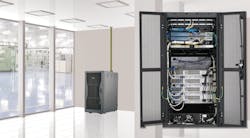The widespread adoption of Ethernet has eliminated many communication challenges, but connectivity still isn’t simple. Vendors throughout the supply chain are devising new ways to help users connect devices while striving to improve efficiency and speed.
Now that Ethernet is the standard link for both front office and industrial operations, corporations are looking for techniques that make it easier to share data throughout the enterprise. Many are focusing on ways to reduce the number of protocols they deploy.
“Specialization is ending,” says Dan McGrath, a Panduit engineer and spokesman for the Industrial IP Advantage, a coalition of companies supporting the use of Internet protocol. “The move to industrial Ethernet has coincided with a move to single-protocol operation, with that protocol supporting all disciplines as a single plantwide communications solution.”
Though the combination of TCP/IP makes that goal possible, using a single protocol isn’t always possible. Many versions of Ethernet are used to meet varying requirements for industrial applications. Most plant floors employ equipment from a range of vendors that use different flavors of Ethernet.
“Ideally, I would advise to try to always use one protocol,” says Joaquin Ocampo, product manager at Bosch Rexroth. “In the real world, due to existing equipment or customer preference, it is not always the case. But if you have peripheries and options like Sercos, the automation bus offers connection to the control, the drives, the distributed I/Os, the touch panel, and many other devices on the machine. This simplifies the wiring and troubleshooting of the machine.”
Networking specialists are devising new ways to further simplify the task of networking equipment on the plant floor. Some groups are developing profiles that provide a common approach for a given industry or application. Many are also devising techniques that make it easier to operate in multi-protocol environments (see “They Can Talk to Anyone”). Others are focusing on ways to make it easier to set up networks, while the entire industry explores varying bandwidth requirements.
Profiles and protocols
For the past few years, ease of use has been one of the major efforts in networking. That focus has come as the basic tasks of communication have solidified. The protocols themselves aren’t changing much, giving industry groups time to focus on developing profiles that address broad focus areas. These profiles provide a solid starting point for integrators.
“Our communication protocol is stable; it hasn’t changed in a couple years,” says Carl Henning, deputy director of PI North America. “We’re doing a lot with application profiles. One of the biggest is ProfiEnergy, which has been around a couple years. It’s now showing up in more places. Studies show that when there are pauses in production, a lot of energy is used. German automakers, who helped drive the development of ProfiEnergy, are early adopters.”
These trends are common in many different aspects of networking. Component suppliers also endorse the emergence of focused profiles. They make it simpler to add value for end users.
“Today, the protocols are very stable; you don’t have to keep a wary eye open,” says Tom Weingartner, marketing vice president at Innovasic. “Anything that’s being added is at a higher level than in the past. Profiles help people quite a bit. They abstract some of the hardware implementation so the software is less impacted by the hardware.”
Another benefit of profiles is that they make it more straightforward to share information. In an era based on remote manufacturing and outsourcing, the ability to communicate with different groups has become quite important. When teams all use the same profile, it improves communication and helps companies configure systems using equipment from various suppliers.
“Profiles set agreements on how information will be arranged so it’s done the same way,” Henning says. “For example, Profinet’s process automation profile has a generic file used in configuration. Any model of a differential pressure transmitter can work without alteration using a standard approach. This also lets you move from one company’s component to another.”
The ability to piggyback safety onto Ethernet is another major step that’s simplified networking installations. As this trend moves further into the mainstream, engineers are devising techniques that help improve efficiency. For example, it’s fairly straightforward to limit emergency shutdowns to specific areas of a line, in contrast to the full-line shutdowns that were common with dedicated safety networks.
“When the network is designed to include a safety network, you don’t need special wiring for safety, and you can control things more intelligently,” says Sari Germanos, technology marketing manager for the Ethernet Powerlink Standardization Group. “If you’re shutting down a packaging line, you might not want to turn everything off when someone pushes the red button that kills power. You only need to turn off the sections that are related to the specific safety issue.”
Network developers are also leveraging the many advances that come with using Internet protocols. The compatibility is a boon for maintenance personnel who know how to use common business tools. These tools can be used to troubleshoot industrial systems.
“Our diagnostic profile lets people take advantage of IP protocols,” Henning says. “They can use Simple Network Management Protocol (SNMP) to see things like the number of retries on a port.”
Configuration challenges
When integrators and managers set up networks, topologies and architectures are among the early issues that must be resolved. Equipment and component developers are using different strategies to make it easier to set up networks and add or update equipment as needs evolve. Adding a second port is a common technique.
“When equipment all has two ports and equipment is connected internally by a hub, you can form a ring, star or another topology,” Germanos says. “There’s no frame forwarding, so you can have 240 devices on a network and not see delays.”
Often, the path to simplify networking architectures depends on the definition of simplicity. An architecture that’s easy to set up may not be the best approach when developers look at the bigger picture and consider future expansion.
“Using managed switches and a structured cabling may seem counterintuitive, since linear topologies with unmanaged switches are far simpler for small systems,” says Paul Brooks, a Rockwell Automation manager representing the Industrial IP Advantage. “Few Ethernet installations stay small, because the value is in the information and that information can’t be stranded. In medium and large networks, the incremental effort to properly architect the physical and switch infrastructure will result in a network that is far easier to maintain, diagnose and extend, resulting in reduced total cost of ownership and ultimately reduced training burden.”
Though many companies are bullish on managed switches, they aren’t universally revered. Some technologies don’t have switches, contending that they hamper rather than help performance.
“Powerlink doesn’t use any switches, so you gain the benefit of seeing all the traffic,” Germanos says. “Switches mask some of the traffic. Powerlink uses hubs, so there’s no forwarding. Forwarding slows things down; a switch has to analyze the packets before it forwards them. In real-time environments, switches are difficult to maintain. Our bus masters control timing.”
Redundancy is another expanding trend. As the price of equipment comes down, it’s easier to add equipment that ensures that a single failure won’t shut down a full line. The huge potential cost of unplanned shutdowns often makes it easy to justify any additional expense. Many protocols make it simple to add duplicate hardware.
“Redundancy is becoming a big deal,” Germanos says. “If a master goes down, the network goes down. Powerlink now supports up to 10 redundant masters on a network, so that’s no longer an issue.”
Need speed?
Regardless of the protocol or topology that’s being used, engineers will spend a fair amount of time talking about speed. For many applications, 100 Mbps Ethernet provides enough bandwidth to meet all requirements. But when functions like motion control and video are added, the need for speed becomes more of a concern.
“There’s a need to optimize networks for real-time performance,” Germanos says. “There’s a lot more imaging, with smart cameras sending video over the network.”
Backbones are another area where higher speeds are necessary. Many integrators use fast networks for backbones, with less expensive links used for equipment that doesn’t have the same bandwidth demands.
“We anticipate that 100 Mbps full duplex will serve the needs of edge devices for the foreseeable future,” McGrath says. “1 Gbps is becoming common at the infrastructure level (switch to switch) and will become the norm connecting to servers and increasingly to high-performance controllers.”
Some suppliers are ramping up for higher speeds even though demand is currently limited. That simplifies product support by eliminating an option. “We’ve designed Gigabit Ethernet into our latest chips, but I’m not sure Gigabit Ethernet will be adopted any time soon,” Weingartner says. “There’s no driving need for gigabit speeds now, unless you’ve got a lot of vision or other high-bandwidth technologies.”
Much of the information sent between machines is not particularly time-critical. That lets system designers give special priority to data types or machines that have more demanding requirements.
“People want protocols to preserve bandwidth for certain things,” Germanos says. “If you have three or four video feeds, you’ll need to guarantee bandwidth so you don’t see degradation. Bandwidth guarantees were pretty much the whole notion behind Powerlink, with a bus master that controls timing and a number of control nodes.”
The effort to guarantee delivery capabilities is happening at many levels. Much activity occurs at the equipment level and during network integration. Component suppliers are also striving to make it simpler for equipment designers to ensure that data packets arrive on time.
“We’ve also included something called PriorityChannel, which makes a device immune to the effects of network loading or network traffic,” Weingartner says. “As traffic gets heavier, equipment won’t slow down. The chip works like a traffic cop without the burden of an application, so users don’t have to deal with the effects of heavy network traffic.”
Software developers are also creating new tools that help integrators and users allocate bandwidth for different pieces of equipment. That lets end users adapt as their networking requirements change.
“Software tools make it easy to design time slots and guarantee that every piece of equipment has the bandwidth it needs to connect,” Germanos says. “It lets users decide when things connect based on their specific needs.”

